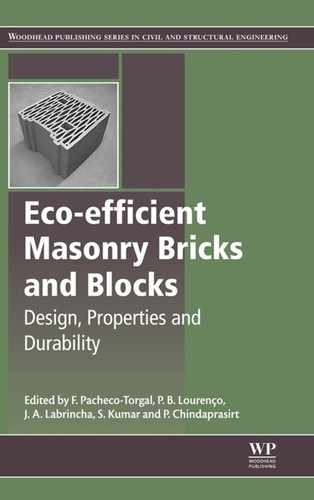Table of Contents
Woodhead Publishing Series in Civil and Structural Engineering
1. Introduction to eco-efficient masonry bricks and blocks
1.1. Brief historical considerations on masonry bricks and blocks: past, present and future
1.2. Contributions of masonry bricks and blocks for eco-efficient construction
2. The design and mechanical performance of high-performance perforated fired masonry bricks
2.2. Conception of fired clay units
2.3. Raw materials used in the production of perforated fired bricks
2.4. Mechanical characteristics of perforated fired bricks
2.5. Masonry assemblages with fired perforated brick masonry
3.5. Conclusions and future trends
4.2. Simulation tools for the assessment of energy performance of buildings
4.4. Computational results and discussion
5. The properties and durability of clay fly ash-based fired masonry bricks
5.3. Fly ash-based fired clay masonry brick processing
5.4. Effects of fly ash on the technological properties
6. Types of waste, properties, and durability of pore-forming waste-based fired masonry bricks
6.2. Industrial waste pore former and the properties of bricks
6.3. Agricultural waste pore formers and properties of bricks
6.6. Sources of further information and advice
7. Types of waste, properties and durability of toxic waste-based fired masonry bricks
7.2. Industrial waste classification used in fired masonry bricks
7.3. Comparison between clay minerals and the alternative raw materials
7.4. Firing conditions used in the manufacture of waste-based fired bricks
7.5. Characteristics of waste-based fired bricks
7.7. Conclusions and future trends
Part Three. The design, properties and durability of Portland cement concrete masonry blocks
8.2. Mix composition and fresh and hardened properties of masonry concrete
8.3. High-pozzolanic industrial by-product content concrete masonry blocks
8.5. Sources of further information and advice
9. The properties and durability of autoclaved aerated concrete masonry blocks
9.2. Types of lightweight concrete
9.3. Autoclaved aerated concrete (AAC) history and utilization as masonry blocks
9.4. Manufacturing and mechanism of autoclaved aerated concrete
9.5. Physical properties of autoclaved aerated concrete
9.6. Mechanical properties of autoclaved aerated concrete
9.7. Microstructure of autoclaved aerated concrete
9.8. Characterizations of autoclaved aerated concrete
9.9. Thermal conductivity of bottom ash cement autoclaved aerated concrete
9.10. Durability of autoclaved aerated concrete
9.11. Conclusions and future trends
9.12. Sources of further information and advice
10. The design, properties, and performance of concrete masonry blocks with phase change materials
10.2. Phase change material (PCM) candidates for buildings
10.3. Masonry brick designs for PCM
11. The design, properties and performance of shape optimized masonry blocks
11.2. Searching for the optimal masonry block
11.3. Enhanced performance of masonry blocks using optimization techniques
11.4. Conclusions and future trends
Part Four. The design, properties and durability of geopolymeric masonry blocks
12. The properties and durability of fly ash-based geopolymeric masonry bricks
12.3. Mix details of fly ash-based geopolymeric masonry bricks
12.4. Mixing and curing processes
12.5. Physical and mechanical properties
12.6. Microstructure properties
13. The properties and durability of mine tailings-based geopolymeric masonry blocks
13.2. Mine tailings (MT)-based geopolymer
13.3. Synthesis and physical and mechanical properties of MT-based geopolymer masonry blocks
13.4. Durability of MT-based geopolymer masonry blocks
13.5. Environmental performance of MT-based geopolymer masonry blocks
13.6. Conclusions and future trends
14. The properties and performance of red mud-based geopolymeric masonry blocks
14.2. Characterization of red mud
14.3. Suitability of red mud for geopolymeric masonry block
14.4. Synergy of red mud with other waste
14.5. Production of masonry blocks
15.2. Characteristics of geopolymer mortar
15.3. Static compaction device
15.4. Strength development with degree of saturation
15.5. Thermal cured geopolymer blocks
15.6. Ambient cured geopolymer blocks
15.7. Conclusions and future trends
Part Five. The properties and durability of earth-based masonry blocks
16. The properties and durability of adobe earth-based masonry blocks
16.2. Adobe technique and materials
16.4. Durability of adobe blocks
16.5. Future trends for eco-efficient constructions
16.6. Sources of further information and advice
17. The properties of compressed earth-based (CEB) masonry blocks
17.2. Properties of compressed earth-based masonry blocks
17.3. Integration of agricultural waste materials
18. The durability of compressed earth-based masonry blocks
18.2. Factors influencing durability of earth-based masonry
18.3. Use of industrial and agricultural wastes and by-products
18.4. Tests and indicators of durability
Part Six. Topology optimization and environmental performance
19. Topology optimization for the development of eco-efficient masonry units
19.2. The steady-state heat conduction problem
19.3. Optimal design for thermal insulation: problem formulation
19.4. Numerical investigations
19.5. Conclusion and future trends
20. Environmental performance and energy assessment of fired-clay brick masonry
20.2. Life cycle assessments of ceramic masonry units
20.3. Environmental and energy assessments in ceramic manufacturing plants
21. Assessment of the energy and carbon embodied in straw and clay masonry blocks
21.2. Current materials and building efficiency in the region
21.5. Conclusions and future trends
22. Earth-block versus sandcrete-block houses: embodied energy and CO2 assessment
22.2. Embodied energy and CO2: an overview
22.3. Embodied energy and CO2-related studies
22.5. The description of the object of the assessment and system boundary
22.6. The methods of assessment
22.9. Mathematical models underpinning the process analysis approach
22.10. Calculations and the use of tools
22.12. Assessments of embodied energy and CO2: case studies' applications
22.13. Validation of results using building information modeling (BIM) software
